|
|
|
Sort Order |
|
|
|
Items / Page
|
|
|
|
|
|
|
| Srl | Item |
| 1 |
ID:
128576
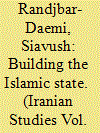

|
|
|
|
|
| Publication |
2013.
|
| Summary/Abstract |
The early drafts of the constitution of 1979 have represented a crucial moment in the creation of the post-revolutionary Iranian state. This article makes use of primary sources of the time and recently revealed material in order to provide a systematic analysis of the events which led to the production of the key versions of the draft constitution and the reaction to them by the multitude of political movements which were then active. The aim of this study is to clarify events and processes which have been left unexplored by the existing academic literature.
|
|
|
|
|
|
|
|
|
|
|
|
|
|
|
|
| 2 |
ID:
046418
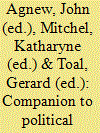

|
|
|
|
|
| Publication |
Malden, Blackwell Publishing, 2003.
|
| Description |
xii, 494p.
|
| Standard Number |
0631220313
|
|
|
|
|
|
|
|
|
|
|
|
Copies: C:1/I:0,R:0,Q:0
Circulation
| Accession# | Call# | Current Location | Status | Policy | Location |
| 046327 | 320.12/AGN 046327 | Main | On Shelf | General | |
|
|
|
|
| 3 |
ID:
124150
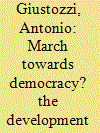

|
|
|
|
|
| Publication |
2013.
|
| Summary/Abstract |
Although the post-2001 period in Afghanistan has been hailed as a return to an earlier process of democratic opening that was interrupted in the early 1970s, a comparison of the development of political movements up to 1978 and then after 2001 highlights important differences. Until the late 1960s, Afghan political parties were mainly focused on influencing a supposedly enlightened leadership towards faster modernization of the country. Their disillusion was beginning to push them towards the development of forms of organization which could mobilize sections of the population on their behalf, even if tentatively so. Little comparable effort was noticeable after 2001, when parties big and small, seemed intent mainly on securing a position from which to develop a following based on the distribution of patronage. It could be argued that the availability of resources on a large scale following international intervention in 2001 drove the Afghan political system in a direction quite different from the path which was initially embarked upon in the 1960s.
|
|
|
|
|
|
|
|
|
|
|
|
|
|
|
|
| 4 |
ID:
087520
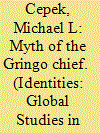

|
|
|
|
|
| Publication |
2009.
|
| Summary/Abstract |
In this article, I investigate the sociocultural grounding and sociopolitical position of Randy Borman, the "gringo chief" of the indigenous Cof n people of Amazonian Ecuador. Born to North American missionary-linguists, Borman grew up in Cof n communities, attended school in urban Ecuador and the United States, and developed into the most important Cof n activist on the global stage. I consider him alongside other ethnically ambiguous leaders of Amazonian political movements, whom anthropologists have described as "messianic" figures. The historians and ethnographers who write about Amazonian messianism debate the relationship between myth and reason in indigenous political action. Using their discussion as a starting point, I propose the concept of "mythical politics," a type of transformative action that concentrates enabling forms of socio-temporal mediation in the shape of individual actors and instantaneous events. I develop my approach through a discussion of the work of Georges Sorel, Georg Luk cs, and Antonio Gramsci, three theorists who debate the role of myth in political mobilization. By applying their insights to the case of Borman, I explore the relationship between myth, mediation, and rationality in Cof n politics and political movements more generally.
|
|
|
|
|
|
|
|
|
|
|
|
|
|
|
|
| 5 |
ID:
138855
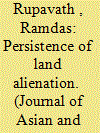

|
|
|
|
|
| Summary/Abstract |
This article provides an overview of the policies of the colonial and post-colonial state regarding the tribal people of Andhra Pradesh. The penetration of colonial capital, the policies of the Nizam state which supported this and the resultant process of land alienation is analysed, followed by the presentation of various attempts by the post-colonial state to return tribal land by means of the Land Regulation Act, to rectify the wrongs of the past and to halt any further alienation. The article concludes by arguing that the state has not been successful in ending the process of land alienation which destroys tribal life.
|
|
|
|
|
|
|
|
|
|
|
|
|
|
|
|
| 6 |
ID:
104834
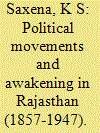

|
|
|
|
|
| Publication |
New Delhi, S Chand, 1971.
|
| Description |
xvi, 284p.hbk
|
|
|
|
|
|
|
|
|
|
|
|
Copies: C:1/I:0,R:0,Q:0
Circulation
| Accession# | Call# | Current Location | Status | Policy | Location |
| 008324 | 954.4/SAX 008324 | Main | On Shelf | General | |
|
|
|
|
| 7 |
ID:
129067
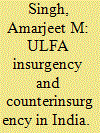

|
|
|
|
|
| Publication |
2014.
|
| Summary/Abstract |
Assam is a land of different cultural groups. Prior to the advent of the Ahoms, the Mongolian people from Thailand, in the 13th century, different regions of Assam were ruled by different dynasties such as Plas, Koches, Kacharis and Chutiyas. The Ahoms invaded Assam in 1236. The land was named "Asom" by the Ahoms (Assam is its an glicised form). Down the line, they have assimilated into the culture of this land.' The Burmese invaded Assam in 1818 and the Ahorns rulers could not stop them. Thus, the British started interfering in the politics of Assam. Assam came under British rule after the Treaty of Yandabo signed between the Burmese and the British in 1826. In 1838, Assam was amalgamated with Bengal. Assam became a province in 1874. In 1905, Bengal was partitioned; Assam was also amalgamated with eastern part of Bengal. In 1912, Bengal was reunited; again, Assam became a province. After the partition of India
and Pakistan in 1947, Sylhet district of Assam (leaving Karimganj to India) was transferred to Pakistan. Finally, Assam became a state of India in 1950. Down the line, the states of Nagaland, Meghalaya, Mizoram and Arunachal Pradesh were created out of Assam. With a population of about 31 million (Indian Census 2011), Assam is one of the most ethnically and linguistically diverse states of India. Assam has been witnessing different kinds of political movements of varying scale ranging from the movement which sought to establish an independent state of Assam to the formation of new states (provinces) within India? Thus Assam has been the victim of violence unleashed by different insurgent groups in which two of them have been banned by the government for seeking
|
|
|
|
|
|
|
|
|
|
|
|
|
|
|
|
|
|
|
|
|